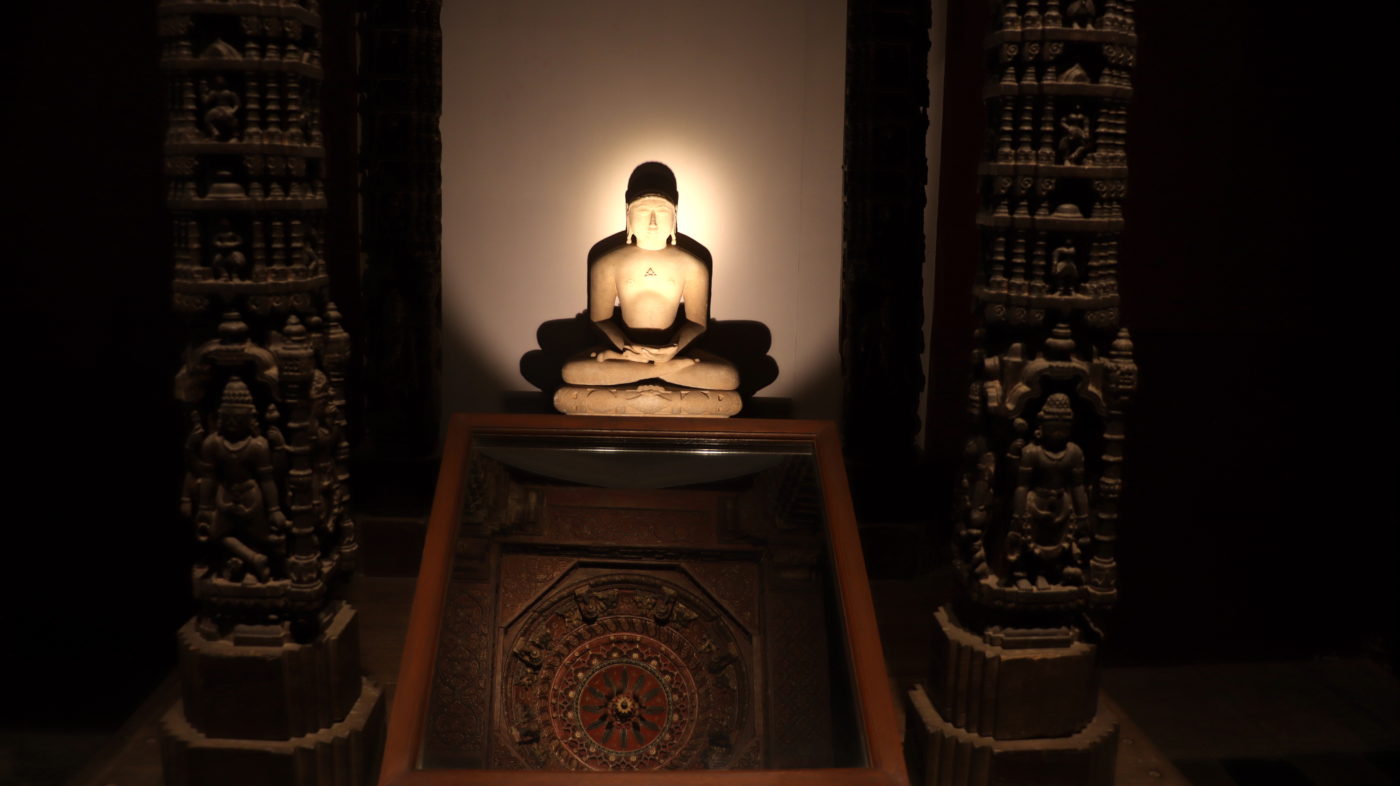
What Is Jainism? The Basics of Jainism in 10 Questions, 10 Definitions, and 10 Quotes
What are the basics of Jainism? Jainism is a religion arising from India which invites its adherents to liberation from rebirth by seeking non-violence and shedding karmic matter. It teaches how a soul can be purified of this karmic non-life (ajiva) through following the teachings of its founder Mahavira. Mahavira is the most recent of 24 “tirthankaras” who taught Jainism throughout the past cycle of time. His story of renunciation and liberation and years as a traveling preacher has similarities with Gautama, the founder of Buddhism.
What are the basics of Jainism? 10 Questions
- Like Buddhism, Jainism is an offshoot of what religion? Hinduism
- The story of Mahavira, the founder of Jainism, closely parallels the life of what other world religion founder? the Buddha
- What is the historic name of Mahavira (“great hero”), a Kshatriya born of royalty in Northeast India? Nataputta Vardhamana
- Mahavira left his wife and daughter to embark on a spiritual journey of self-discipline. After over a decade of self-deprivation (such as walking about without any possessions—even without a begging bowl or clothing), he attained supreme what? knowledge
- Mahavira became a traveling teacher who preached reform all over India, most notably in the need for nonviolence (to any and all living things), a principle known as what? ahimsa
- What famous convert to Jainism founded the powerful Maurya Empire? Chandragupta Maurya
- The pursuit of right faith, right knowledge, and right action rids a person of karmic matter (ajiva) and puts the person on the path for liberation. Collectively, what are these three lifestyle essentials called? the Three Jewels
- Jainism forbids violence, dishonesty, theft, attachment, and sexual activity. These prohibitions are stricter for monks and nuns but also binding on laity within their ability (e.g., for laity, no sexual activity becomes no sexual immorality). What are these five prohibitions called? the Five Vows
- Jain celebrations include Hindu festivals such as Diwali, Mahavira’s birthday, and Paryushana (a festival celebrating the “abiding together” between monks and householders). Every 12 years, a festival takes place in which Jains anoint what? Jain statues
- Jains follow a daily prayer routine, including 48 minutes of meditation. They also visit the temples to make offerings to the Tirthankara statues. What are these devotional offerings called? puja
What are the basics of Jainism? 10 Definitions
- Jina – “Conqueror”
- Jain – “One who follows the conqueror”
- Tirthankaras – the 24 “ford-makers” or “bridge-builders” revered as teachers of Jainism throughout each cycle of time; Mahavira is the 24th in the current cycle
- Dusama Dusama – a period of decline which ends the current cycle of time before another begins
- Agamas – a collection of sutras from Mahavira which comprise the Jain scriptures
- Svetambara – the “white-robed” and larger sect of Jainism which tends to be more liberal in its interpretation of Jain scriptures (e.g., nuns are admitted as well as monks; it is permissible to collect food from householders more than once a day)
- Digambara – the “sky-clad” sect of Jainism which strictly forbids any and all possible forms of attachment, including clothing, begging bowls, and even encourages starvation once one attains enlightenment
- Ajiva – karmic matter which accumulates to the person and must be shed through self-discipline in order to achieve liberation, which is often called “moksha” or “nirvana”
- Namaskara Mantra – A daily pre-dawn prayer which says, “I bow to the enlightened souls, I bow to the liberated souls, I bow to religious leaders, I bow to the religious teachers, I bow to all the monks in the world”
- Celebration of Death – the voluntary act of fasting to death as an ultimate act of total detachment in anticipation of ultimate release
What are the basics of Jainism? 10 Quotes
The Life of Mahavira
“In [the astronomical phase] Uttaraphalgunî he [Mahavira] was born; in Uttaraphalgunî, tearing out his hair, he left the house and entered the state of houselessness; in Uttaraphalgunî he obtained the highest knowledge and intuition, called Kevala, which is infinite, supreme, unobstructed, unimpeded, complete, and perfect. But in [the astronomical phase] Svâti the Venerable One obtained final liberation.”
– The Kalpa Sutra of Bhadrabahu, Lives of the Ginas, Life of Mahavira, Lecture 1, translated by Hermann Jacobi
“The Venerable Ascetic Mahâvîra for a year and a month wore clothes; after that time he walked about naked, and accepted the alms in the hollow of his hand. For more than twelve years the Venerable Ascetic Mahâvira neglected his body and abandoned the care of it; he with equanimity bore, underwent, and suffered all pleasant or unpleasant occurrences arising from divine powers, men, or animals.”
– The Kalpa Sutra of Bhadrabahu, Lives of the Ginas, Life of Mahavira, Lecture 5, translated by Hermann Jacobi
The basics of Jainism: “He with equanimity bore, underwent, and suffered all pleasant or unpleasant occurrences.”
“Before the Venerable Ascetic Mahâvîra had adopted the life of a householder (i.e. before his marriage) he possessed supreme, unlimited, unimpeded knowledge and intuition. The Venerable Ascetic Mahâvîra perceived with this his supreme unlimited knowledge and intuition that the time for his Renunciation had come. He left his silver, he left his gold, he left his riches, corn, majesty, and kingdom; his army, grain, treasure, storehouse, town, seraglio, and subjects; he quitted and rejected his real, valuable property, such as riches, gold, precious stones, jewels, pearls, conches, stones, corals, rubies, &c.; he distributed presents through proper persons, he distributed presents among indigent persons.”
– The Kalpa Sutra of Bhadrabahu, Lives of the Ginas, Life of Mahavira, Lecture 5, translated by Hermann Jacobi
Death and Existence
“When the duration of time of the existence of soul in the body comes to an end, the body is left and the soul according to the Ayu Karma (its deeds in this birth by which he earns the life span of the next birth) goes away to another place, takes a new birth, and there lives in a new body….In this way from the eternal past, the line of births and deaths continues according to karma (deeds of each soul).”
– Shri Jayatilal S. Sanghvi, A Treatise on Jainism, Chapter 3
“Jain Philosophy does not give credence to the theory that the God is a creator, survivor, or destroyer of the universe. On the contrary, it asserts that the universe has always existed and will always exist in exact adherence to the laws of the cosmos. There is nothing but infinity both in the past and in the future.”
– “Six Universal Substances (Dravyas),” compiled by Pravin K. Shah
The Problem in Life
“A man that does not comprehend and renounce the causes of sin, descends in a cardinal or intermediate direction, wanders to all cardinal or intermediate directions, is born again and again in manifold births, experiences all painful feelings.”
– Akaranga Sutra, Book 1, Lecture 1, Lesson 1, translated by Hermann Jacobi
The basics of Jainism: “…born again and again in manifold births, experiences all painful feelings…”
“Unhappy creatures, world-wise are those who, not freeing themselves from ignorance, talk about final liberation: they turn round and round in the whirlpool (of births).”
– Akaranga Sutra, Book 1, Lecture 5, Lesson 1, translated by Hermann Jacobi
The Path to Liberation
“Right knowledge, right faith, and right conduct are the three most essentials for attaining liberation. In order to acquire these, one must observe the five great vows: non-violence (ahimsa), truth (satya), non-stealing (achaurya or asteya), celibacy/chastity (brahmacharya), non-attachment/non-possession (aparigraha).”
– “Five Great Vows (Maha-vratas),” compiled by Pravin K. Shah
“Generally Jains use the following eight items to perform puja of a Tirthankara in the temple. Symbolically each item represents a specific religious virtue and one should reflect on it while performing puja: water, sandal-wood, flower, incense, candle, rice, sweet food, fruit.”
– “Meaning of Ashta Prakari Puja,” compiled by Pravin K. Shah
“Ahimsa Parmo Dharma (nonviolence is the paramount religion) epitomize the true essence of Jainism. This suggests that one should bear love towards all living beings, as they are considered potentially divine in whatever form they exist. All of them have the capacity to be liberated from the endless cycle of birth and rebirth and attain eternal bliss. Attainment of the purity and liberation of the soul are achieved by the means of Right Faith, the Right Knowledge and the Right Conduct.”
– Shri Jayatilal S. Sanghvi, A Treatise on Jainism, Chapter 1
The basics of Jainism: “One should bear love towards all living beings, as they are considered potentially divine in whatever form they exist.”
2 Questions about Jainism for Christians to Consider
- What is the greatest thing that a person can hope for, according to Mahavira? What is the greatest thing a person can hope for, according to Jesus?
- According to Christianity, how should we view our material possessions? When can they become dangerous?








